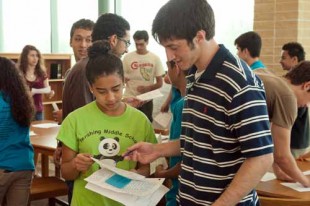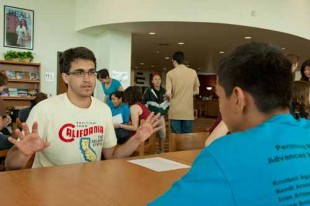Spanish students, middle-schoolers talk culture and heritage, en Español
In the sunlit library of Houston’s Pershing Middle School, 38 students lined up last week in pairs at long wooden tables. Half were Pershing eighth-graders enrolled in advanced placement (AP) Spanish; across from them, students from Rice.
“¿Cómo estás?,” they greeted one another, familiar from the beginning. And after a quick icebreaker, the twosomes leaned in and got down to business – a lengthy personal discussion en Español.
Last Friday’s “intercambio,” or exchange, was designed to let bicultural, Spanish-speaking students share their experiences and learn from each other. It was also a way for some local eighth-graders to talk one-on-one with college students about higher education.
The Rice students – 19 of them – take courses through the university’s Center for the Study of Languages. Their families hail from Spain, Cuba, Ecuador, Colombia, Venezuela, Honduras and Mexico, and they’re enrolled in “heritage track” Spanish courses designed for bicultural students.

Rice students and Pershing Middle School eighth-graders started their exchange with an icebreaker game in Spanish.
The students generally grew up speaking Spanish with their families or in their neighborhoods, but many of them didn’t receive a formal education in the language until now, said Elizabeth Cummins Muñoz, who teaches the intermediate-level SPAN 204.
“This is often the first Spanish class they’ve taken,” she said.
The eighth-graders are starting their Spanish education earlier. Most of the eighth-graders in the class speak Spanish at home, though many didn’t grow up reading or writing in the language. At Pershing, they’re enrolled in Susan Parsons-López’s AP Spanish class, an advanced language course that will allow them to earn high school and even college credit in Spanish.
Last week, when the two classes met, the sound of rapid, fluent Spanish echoed through the high-ceilinged room. Almost immediately, there was easy laughter as the students talked and discovered what they had in common.
Besides the getting-to-know-you basics, the pairs had a list of questions to discuss – some suitable prompts in case conversation lagged:
¿Por qué es importante para ti estudiar el Español? (Why is it important for you to study Spanish?)
¿Con quién hablas el Español a hora? (With whom do you speak Spanish now?)
¿Hay diferencias culturales entre tus padres y tú? (Are there cultural differences between you and your parents?)
As they talked about their lives and their family backgrounds, the college students and the eighth-graders discovered they had plenty of things in common.
Two students learned they’re both from Monterrey, Mexico. One pair discovered they both want to be doctors. And another pair discovered that they both want to be engineers.
Samuel De La Torre, a Brown College freshman, answered a lot of questions for his eighth-grade partner.
“He was interested in my major, mechanical engineering,” De La Torre said. “He was wondering how many years of study he had to go through, what kind of classes, what you do after college.”
De La Torre also answered some basic questions about college life, including whether he lives on campus and how students can play sports.
“The eighth-graders are asking a lot about universities, about college,” Cummins Muñoz said – and some are realizing, for the first time, that they might be able to get there.
“Some really had no understanding of the process at all – some didn’t understand [college] was accessible,” Cummins Muñoz said. “So there’s a sort of community mentor role these [Rice] students are fulfilling.”
The Pershing eighth-graders will soon take the college-level AP exam, which enables them to earn both high school and college credit.
“It makes them think about the future” to take a course for college credit, said their teacher, Parsons-López. And meeting bicultural college students, she said, is “inspiring.”
“They see other kids like them who are at Rice,” Parsons-López said, “and they get information about Rice and college in general.”
For young teens about to enter high school, that’s valuable information at a crucial age, Cummins Muñoz said.
“A lot of them have no idea you can get scholarships for college,” she said, and therefore haven’t pictured themselves at a university. Besides, Cummins Muñoz said, it’s helpful for the kids to know Rice students who speak Spanish and navigate two cultures successfully. She said she hoped her bicultural college students would form a bond with their eighth-grade counterparts.
“My goal is to get these Rice students to an understanding that they form part of a specific community,” Cummins Muñoz said.
It’s the first time Rice’s “heritage track” Spanish classes have worked with middle-school kids in such large numbers, said Patricia Brogdon-Gómez, who teaches the advanced SPAN 303. A handful of Rice students visited Pershing last year, she said. They talked to eighth-graders in groups, and the kids were so curious and eager to share that it was obvious the program should be expanded.
Last week’s group from Rice had students from three classes, and they all managed to develop rapport and have meaningful conversations with their younger partners.
“I think we’re definitely going to have to repeat this in the fall,” Brodgon-Gómez said.



Leave a Reply